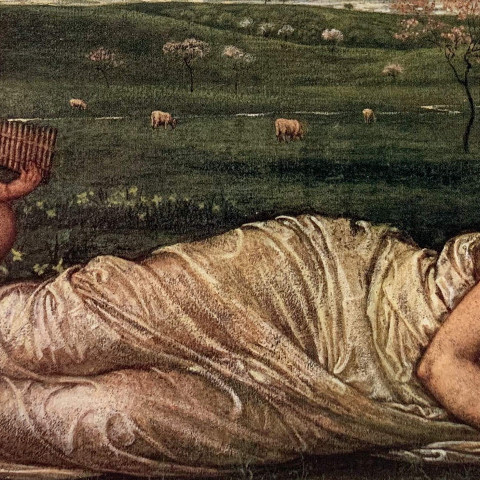Walter Crane was an English artist and book illustrator. He is considered to be the most influential, and among the most prolific, children's book creator of his generation and, along with Randolph Caldecott and Kate Greenaway, one of the strongest contributors to the child's nursery motif that the genre of English children's illustrated literature would exhibit in its developmental stages in the latter 19th century. His work featured some of the more colourful and detailed beginnings of the child-in-the-garden motifs that would characterize many nursery rhymes and children's stories for decades to come. He was part of the Arts and Crafts movement and produced an array of paintings, illustrations, children's books, ceramic tiles and other decorative arts.
Walter Crane was born in Liverpool, England on 15 August 1845, the second son of Thomas Crane, a portrait painter and miniaturist. He was a fluent follower of the newer art movements and he came to study and appreciate the detailed senses of the Pre-Raphaelite Brotherhood, and was also a diligent student of the renowned artist and critic John Ruskin. A set of colored page designs to illustrate Tennyson's "Lady of Shalott" gained the approval of wood-engraver William James Linton to whom Walter Crane was apprenticed for three years (1859-1862). As a wood-engraver he had abundant opportunity for the minute study of the contemporary artists whose work passed through his hands, of Pre-Raphaelites Dante Gabriel Rossetti and John Everett Millais, as well as Alice in Wonderland illustrator Sir John Tenniel and Frederick Sandys. He was a student who admired the masters of the Italian Renaissance, however he was more influenced by the Elgin marbles in the British Museum. A further and important element in the development of his talent was the study of Japanese color-prints, the methods of which he imitated in a series of toy books, which started a new fashion.
From the early 1880s, initially under William Morris's influence, Crane was closely associated with the Socialist movement. He did as much as Morris himself to bring art into the daily life of all classes. With this object in view he devoted much attention to designs for textiles and wallpapers, and to house decoration; but he also used his art for the direct advancement of the Socialist cause. For a long time he provided the weekly cartoons for the Socialist organs Justice, The Commonweal and The Clarion. Many of these were collected as Cartoons for the Cause. He devoted much time and energy to the work of the Art Workers Guild, and to the Arts and Crafts Exhibition Society, founded by him in 1888. He was also a Vice President of the Healthy and Artistic Dress Union, a movement begun in 1890, whose aim was to promote the loose-fitting clothing, in opposition to "stiffness, tightness and weight". They produced numerous pamphlets setting out their cause, including one entitled 'How to Dress Without a Corset' which Crane illustrated.
Although not himself an anarchist, Crane contributed to several libertarian publishers, including Liberty Press and Freedom Press. Following the Haymarket bombing, Crane made multiple trips to America where he spoke in defence of the eight anarchists accused of murder.
In 1862 his picture The Lady of Shalott was exhibited at the Royal Academy, but the Academy steadily refused his maturer work and after the opening of the Grosvenor Gallery in 1877, he ceased to send pictures to Burlington House. In 1863 the printer Edmund Evans employed Crane to illustrate yellowbacks, and in 1865 they began to collaborate on toy books of nursery rhymes and fairy tales. From 1865 to 1876 Crane and Evans produced two to three toy books each year.
In 1864 he began to illustrate a series of sixpenny toy books of nursery rhymes in three coours for Edmund Evans. He was allowed more freedom in a series beginning with The Frog Prince (1874) which showed markedly the influence of Japanese art, and of a long visit to Italy following on his marriage in 1871. His work was characterized by sharp outlines and flat tints. The Baby's Opera was a book of English nursery songs planned in 1877 with Evans, and a third series of children's books with the collective title Romance of the Three R's provided a regular course of instruction in art for the nursery. In his early "Lady of Shalott", the artist had shown his preoccupation with unity of design in book illustration by printing in the words of the poem himself, in the view that this union of the calligrapher's and the decorator's art was one secret of the beauty of the old illuminated books.
His own easel pictures, chiefly allegorical in subject, among them The Bridge of Life (1884) and The Mower (1891), were exhibited regularly at the Grosvenor Gallery and later at the New Gallery. Neptune's Horses was exhibited at the New Gallery in 1893, and with it may be classed his Rainbow and the Wave.
His varied work includes examples of plaster relief, tiles, stained glass, pottery, wallpaper and textile designs, in all of which he applied the principle that in purely decorative design "the artist works freest and best without direct reference to nature, and should have learned the forms he makes use of by heart." An exhibition of his work of different kinds was held at the Fine Art Society's galleries in Bond Street in 1891, and taken to the United States in the same year by the artist himself. It was afterwards exhibited in Germany, Austria and Scandinavia.
Walter Crane died on 14 March 1915 in Horsham Hospital, West Sussex. His body was cremated at the Golders Green Crematorium, where his ashes remain. He was survived by three children, Beatrice, Lionel and Lancelot.
Source: askart.com

